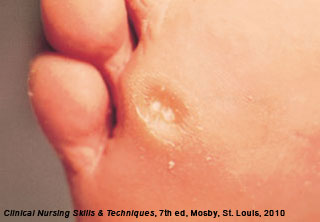What to Do
Look at the Feet
When you care for a person at home, especially an older adult, a diabetic, or a person who has poor circulation to the legs – look at their feet daily. Have the person look at their feet the same time you do. Use of a mirror helps. Look at the top, bottom, sides, and between the toes of each foot. Look for:
- New areas of redness
- Swelling
- Cuts
- Scratches
- Blisters
- Calluses, corns, or soft areas of the skin
- Discolored areas any where on the foot, or around the nails
Take your hands to feel the surface of the feet. If the skin is dry, use a good skin lotion to protect the feet from cracking and drying. Rub the lotion in well and make sure the feet feel dry after applying the lotion. Excess lotion left on the skin or between the toes often leaves moisture, which can cause an infection.
Also, look closely at the heels, which can dry out and crack. Soft areas on the heels are common in people who are in bed a lot of the time. The areas form from friction between the heels and bed sheets and pressure of keeping the heels in one position. These soft areas need to be watched closely, because they can be a sign of skin breakdown and pressure ulcer formation.
Watch How a Person Walks
When caring for another person, watch how he or she walks. Have the person walk a straight line or down a hallway. If the person limps or has an unnatural step, it may mean he or she has a foot problem.
Care of Cuts
If the person has a minor cut on the foot or toes, wash it thoroughly with soap and warm water. After drying, apply a mild over-the-counter antiseptic (e.g. Neosporin ointment) to the cut. Call the doctor for serious cuts or lacerations or if the minor cut does not seem to be healing or shows signs of infection (e.g. redness, pain, drainage).
Ingrown or Thick Nails
If the person you care for has an ingrown toenail or thick, heavy nails that are hard to file down, make an appointment with a podiatrist.

Corns and Calluses
A corn is a raised, cone shaped area that forms on the foot as a result of friction and pressure from shoes. A corn is tender and can be painful when a person walks. A callus is a thickened portion of skin also caused by friction and pressure. Discomfort is common from tight fitting shoes placing pressure on a callus. Do not use caustic over-the-counter chemicals on the feet to remove corns or calluses. Make an appointment with a podiatrist.
Select the Right Shoes
- Always buy shoes near the end of the day when the feet are normally swollen from standing most of the day.
- Have the person buy shoes with non-skid soles that are flexible. A good shoe is sturdy, closed-toed, and does not restrict movement of the feet.
- If the person has a bony deformity like a bunion, extra wide or extra deep shoes with cushioned insoles are best.
- Do not wear new shoes for an extended time. Wear them for short periods over several days so as to break them in.